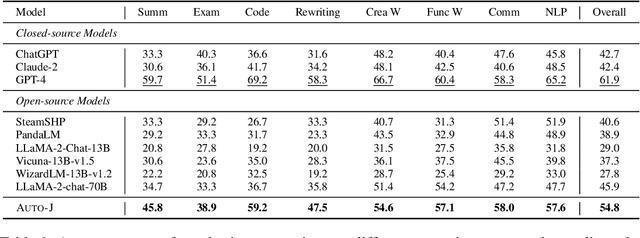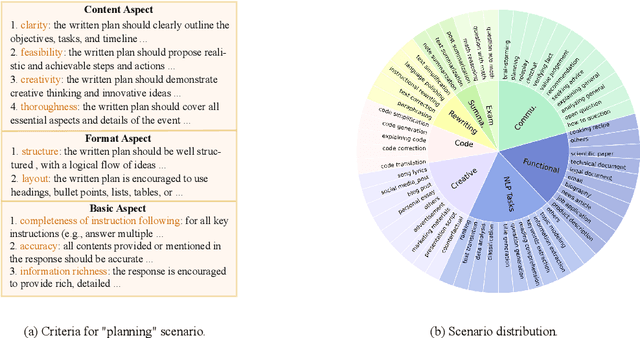Hai Zhao
Department of Computer Science and Engineering, Shanghai Jiao Tong University, Key Laboratory of Shanghai Education Commission for Intelligent Interaction and Cognitive Engineering, Shanghai Jiao Tong University, MoE Key Lab of Artificial Intelligence, AI Institute, Shanghai Jiao Tong University
Igniting Language Intelligence: The Hitchhiker's Guide From Chain-of-Thought Reasoning to Language Agents
Nov 20, 2023



Abstract:Large language models (LLMs) have dramatically enhanced the field of language intelligence, as demonstrably evidenced by their formidable empirical performance across a spectrum of complex reasoning tasks. Additionally, theoretical proofs have illuminated their emergent reasoning capabilities, providing a compelling showcase of their advanced cognitive abilities in linguistic contexts. Critical to their remarkable efficacy in handling complex reasoning tasks, LLMs leverage the intriguing chain-of-thought (CoT) reasoning techniques, obliging them to formulate intermediate steps en route to deriving an answer. The CoT reasoning approach has not only exhibited proficiency in amplifying reasoning performance but also in enhancing interpretability, controllability, and flexibility. In light of these merits, recent research endeavors have extended CoT reasoning methodologies to nurture the development of autonomous language agents, which adeptly adhere to language instructions and execute actions within varied environments. This survey paper orchestrates a thorough discourse, penetrating vital research dimensions, encompassing: (i) the foundational mechanics of CoT techniques, with a focus on elucidating the circumstances and justification behind its efficacy; (ii) the paradigm shift in CoT; and (iii) the burgeoning of language agents fortified by CoT approaches. Prospective research avenues envelop explorations into generalization, efficiency, customization, scaling, and safety. This paper caters to a wide audience, including beginners seeking comprehensive knowledge of CoT reasoning and language agents, as well as experienced researchers interested in foundational mechanics and engaging in cutting-edge discussions on these topics. A repository for the related papers is available at https://github.com/Zoeyyao27/CoT-Igniting-Agent.
Multi-grained Evidence Inference for Multi-choice Reading Comprehension
Oct 27, 2023



Abstract:Multi-choice Machine Reading Comprehension (MRC) is a major and challenging task for machines to answer questions according to provided options. Answers in multi-choice MRC cannot be directly extracted in the given passages, and essentially require machines capable of reasoning from accurate extracted evidence. However, the critical evidence may be as simple as just one word or phrase, while it is hidden in the given redundant, noisy passage with multiple linguistic hierarchies from phrase, fragment, sentence until the entire passage. We thus propose a novel general-purpose model enhancement which integrates multi-grained evidence comprehensively, named Multi-grained evidence inferencer (Mugen), to make up for the inability. Mugen extracts three different granularities of evidence: coarse-, middle- and fine-grained evidence, and integrates evidence with the original passages, achieving significant and consistent performance improvement on four multi-choice MRC benchmarks.
* Accepted by TASLP 2023, vol. 31, pp. 3896-3907
Self-prompted Chain-of-Thought on Large Language Models for Open-domain Multi-hop Reasoning
Oct 23, 2023



Abstract:In open-domain question-answering (ODQA), most existing questions require single-hop reasoning on commonsense. To further extend this task, we officially introduce open-domain multi-hop reasoning (ODMR) by answering multi-hop questions with explicit reasoning steps in open-domain setting. Recently, large language models (LLMs) have found significant utility in facilitating ODQA without external corpus. Furthermore, chain-of-thought (CoT) prompting boosts the reasoning capability of LLMs to a greater extent with manual or automated paradigms. However, existing automated methods lack of quality assurance, while manual approaches suffer from limited scalability and poor diversity, hindering the capabilities of LLMs. In this paper, we propose Self-prompted Chain-of-Thought (SP-CoT), an automated framework to mass-produce high quality CoTs of LLMs, by LLMs and for LLMs. SP-CoT introduces an automated generation pipeline of high quality ODMR datasets, an adaptive sampler for in-context CoT selection and self-prompted inference via in-context learning. Extensive experiments on four multi-hop question-answering benchmarks show that our proposed SP-CoT not only significantly surpasses the previous SOTA methods on large-scale (175B) LLMs, but also nearly doubles the zero-shot performance of small-scale (13B) LLMs. Further analysis reveals the remarkable capability of SP-CoT to elicit direct and concise intermediate reasoning steps by recalling $\sim$50\% of intermediate answers on MuSiQue-Ans dataset.
Meta-CoT: Generalizable Chain-of-Thought Prompting in Mixed-task Scenarios with Large Language Models
Oct 11, 2023



Abstract:Large language models (LLMs) have unveiled remarkable reasoning capabilities by exploiting chain-of-thought (CoT) prompting, which generates intermediate reasoning chains to serve as the rationale for deriving the answer. However, current CoT methods either simply employ general prompts such as Let's think step by step, or heavily rely on handcrafted task-specific demonstrations to attain preferable performances, thereby engendering an inescapable gap between performance and generalization. To bridge this gap, we propose Meta-CoT, a generalizable CoT prompting method in mixed-task scenarios where the type of input questions is unknown. Meta-CoT firstly categorizes the scenario based on the input question and subsequently constructs diverse demonstrations from the corresponding data pool in an automatic pattern. Meta-CoT simultaneously enjoys remarkable performances on ten public benchmark reasoning tasks and superior generalization capabilities. Notably, Meta-CoT achieves the state-of-the-art result on SVAMP (93.7%) without any additional program-aided methods. Our further experiments on five out-of-distribution datasets verify the stability and generality of Meta-CoT.
Empower Nested Boolean Logic via Self-Supervised Curriculum Learning
Oct 09, 2023Abstract:Beyond the great cognitive powers showcased by language models, it is crucial to scrutinize whether their reasoning capabilities stem from strong generalization or merely exposure to relevant data. As opposed to constructing increasingly complex logic, this paper probes into the boolean logic, the root capability of a logical reasoner. We find that any pre-trained language models even including large language models only behave like a random selector in the face of multi-nested boolean logic, a task that humans can handle with ease. To empower language models with this fundamental capability, this paper proposes a new self-supervised learning method \textit{Curriculum Logical Reasoning} (\textsc{Clr}), where we augment the training data with nested boolean logic chain step-by-step, and program the training from simpler logical patterns gradually to harder ones. This new training paradigm allows language models to effectively generalize to much harder and longer-hop logic, which can hardly be learned through naive training. Furthermore, we show that boolean logic is a great foundation for improving the subsequent general logical tasks.
Generative Judge for Evaluating Alignment
Oct 09, 2023



Abstract:The rapid development of Large Language Models (LLMs) has substantially expanded the range of tasks they can address. In the field of Natural Language Processing (NLP), researchers have shifted their focus from conventional NLP tasks (e.g., sequence tagging and parsing) towards tasks that revolve around aligning with human needs (e.g., brainstorming and email writing). This shift in task distribution imposes new requirements on evaluating these aligned models regarding generality (i.e., assessing performance across diverse scenarios), flexibility (i.e., examining under different protocols), and interpretability (i.e., scrutinizing models with explanations). In this paper, we propose a generative judge with 13B parameters, Auto-J, designed to address these challenges. Our model is trained on user queries and LLM-generated responses under massive real-world scenarios and accommodates diverse evaluation protocols (e.g., pairwise response comparison and single-response evaluation) with well-structured natural language critiques. To demonstrate the efficacy of our approach, we construct a new testbed covering 58 different scenarios. Experimentally, Auto-J outperforms a series of strong competitors, including both open-source and closed-source models, by a large margin. We also provide detailed analysis and case studies to further reveal the potential of our method and make a variety of resources public at https://github.com/GAIR-NLP/auto-j.
AutoHall: Automated Hallucination Dataset Generation for Large Language Models
Sep 30, 2023



Abstract:While Large language models (LLMs) have garnered widespread applications across various domains due to their powerful language understanding and generation capabilities, the detection of non-factual or hallucinatory content generated by LLMs remains scarce. Currently, one significant challenge in hallucination detection is the laborious task of time-consuming and expensive manual annotation of the hallucinatory generation. To address this issue, this paper first introduces a method for automatically constructing model-specific hallucination datasets based on existing fact-checking datasets called AutoHall. Furthermore, we propose a zero-resource and black-box hallucination detection method based on self-contradiction. We conduct experiments towards prevalent open-/closed-source LLMs, achieving superior hallucination detection performance compared to extant baselines. Moreover, our experiments reveal variations in hallucination proportions and types among different models.
Multi-turn Dialogue Comprehension from a Topic-aware Perspective
Sep 18, 2023Abstract:Dialogue related Machine Reading Comprehension requires language models to effectively decouple and model multi-turn dialogue passages. As a dialogue development goes after the intentions of participants, its topic may not keep constant through the whole passage. Hence, it is non-trivial to detect and leverage the topic shift in dialogue modeling. Topic modeling, although has been widely studied in plain text, deserves far more utilization in dialogue reading comprehension. This paper proposes to model multi-turn dialogues from a topic-aware perspective. We start with a dialogue segmentation algorithm to split a dialogue passage into topic-concentrated fragments in an unsupervised way. Then we use these fragments as topic-aware language processing units in further dialogue comprehension. On one hand, the split segments indict specific topics rather than mixed intentions, thus showing convenient on in-domain topic detection and location. For this task, we design a clustering system with a self-training auto-encoder, and we build two constructed datasets for evaluation. On the other hand, the split segments are an appropriate element of multi-turn dialogue response selection. For this purpose, we further present a novel model, Topic-Aware Dual-Attention Matching (TADAM) Network, which takes topic segments as processing elements and matches response candidates with a dual cross-attention. Empirical studies on three public benchmarks show great improvements over baselines. Our work continues the previous studies on document topic, and brings the dialogue modeling to a novel topic-aware perspective with exhaustive experiments and analyses.
CSPRD: A Financial Policy Retrieval Dataset for Chinese Stock Market
Sep 11, 2023



Abstract:In recent years, great advances in pre-trained language models (PLMs) have sparked considerable research focus and achieved promising performance on the approach of dense passage retrieval, which aims at retrieving relative passages from massive corpus with given questions. However, most of existing datasets mainly benchmark the models with factoid queries of general commonsense, while specialised fields such as finance and economics remain unexplored due to the deficiency of large-scale and high-quality datasets with expert annotations. In this work, we propose a new task, policy retrieval, by introducing the Chinese Stock Policy Retrieval Dataset (CSPRD), which provides 700+ prospectus passages labeled by experienced experts with relevant articles from 10k+ entries in our collected Chinese policy corpus. Experiments on lexical, embedding and fine-tuned bi-encoder models show the effectiveness of our proposed CSPRD yet also suggests ample potential for improvement. Our best performing baseline achieves 56.1% MRR@10, 28.5% NDCG@10, 37.5% Recall@10 and 80.6% Precision@10 on dev set.
Chinese Spelling Correction as Rephrasing Language Model
Aug 17, 2023



Abstract:This paper studies Chinese Spelling Correction (CSC), which aims to detect and correct potential spelling errors in a given sentence. Current state-of-the-art methods regard CSC as a sequence tagging task and fine-tune BERT-based models on sentence pairs. However, we note a critical flaw in the process of tagging one character to another, that the correction is excessively conditioned on the error. This is opposite from human mindset, where individuals rephrase the complete sentence based on its semantics, rather than solely on the error patterns memorized before. Such a counter-intuitive learning process results in the bottleneck of generalizability and transferability of machine spelling correction. To address this, we propose $Rephrasing Language Modeling$ (ReLM), where the model is trained to rephrase the entire sentence by infilling additional slots, instead of character-to-character tagging. This novel training paradigm achieves the new state-of-the-art results across fine-tuned and zero-shot CSC benchmarks, outperforming previous counterparts by a large margin. Our method also learns transferable language representation when CSC is jointly trained with other tasks.
 Add to Chrome
Add to Chrome Add to Firefox
Add to Firefox Add to Edge
Add to Edge